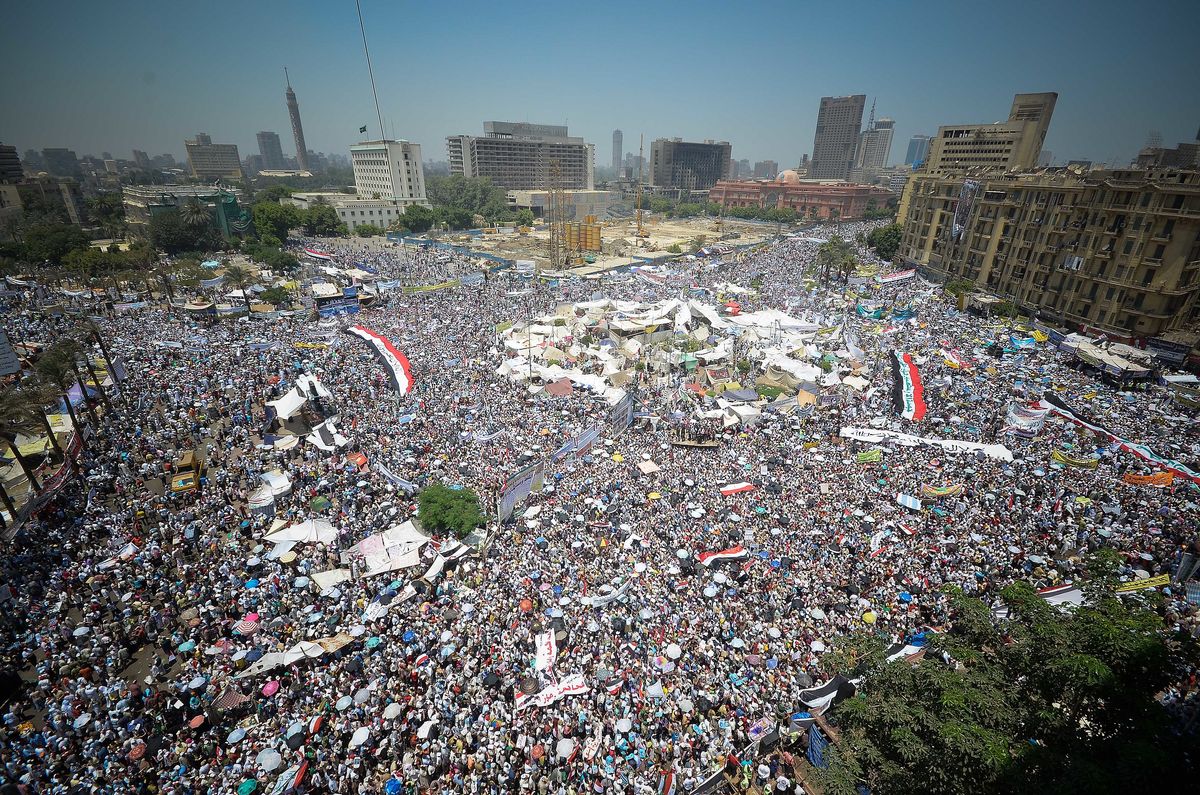Democratic Transition & Authoritarian Exceptionalism

This paper evaluates competing theories about democratic transition, especially as they relate to the modern Middle East. It ultimately uses the case of Egypt, during and after the Arab Uprisings, to highlight the shortcomings of the popular transition paradigm and challenge theorists who contend that Islam is to blame for the widespread authoritarianism in the region. It concludes that domination by a single political faction and the strength of a state’s coercive apparatus play a central role in the perpetuation of authoritarianism.
Beginning in the second half of the 20th century, global trends seemed to point away from authoritarianism and toward political liberalization. Political scientists deemed this the “third wave of democracy.”[1] As politicians’ desire to take advantage of this and spread democracy grew, political scientists raced to codify and analyze the phenomenon, and the available literature grew exponentially.[2] An unfortunate consequence of this approach was the establishment of an imperfect body of scholarship. Many political scientists, though certainly not all, shied away from defining central terms, over-emphasized certain practices while neglecting others, and contorted reality in order to identify common ground in disparate cases.[3] Much of the literature centers upon a transition paradigm. The paradigm assumes the following: any state moving away from authoritarianism is moving toward democracy; all democratizing states undergo political opening, followed by democratic breakthrough and consolidation; elections are of a determinative nature; and structural conditions in transitioning nations have no bearing on the success of the transition.[4]
In The End of the Transition Paradigm, Thomas Carothers confronts these assumptions and concludes that they are incorrect. He argues that not all liberalizing states are moving toward democracy, not all states follow the same path to democracy, not all states with competitive elections are democracies, and structural conditions in transitioning nations are, in fact, remarkably important.[5] With that in mind, Carothers proposes that most states deemed transitioning are not transitioning; they are instead “in the gray zone,” as they are neither democratic nor authoritarian and do not appear to be moving toward democracy.[6] Within the gray zone, he identifies two conditions, feckless pluralism and dominant power politics.[7] The first is characterized by low political participation beyond voting, a pervasive belief in the corrupt nature of the political system, and extreme disillusionment and/or polarization among citizens.[8] By comparison, dominant power politics is characterized by the preeminence of a single political faction, with limited competition and generally weak state institutions.[9] Finally, it is worth noting that both the transition paradigm and Carothers’ theories seek to describe the broader nature of political liberalization and were not created with the Middle East in mind.
Dissimilar from both the transition paradigm and Carothers’ criticism of it, there exist theories of democratization that are unique to the Middle East, the majority of which seek to provide an explanation for the high level of authoritarianism in the region. Within the literature, a sizable portion of existing theories claim that Islam directly threatens democratic ideals and, thus, poses the single greatest challenge to democratization in the Middle East. Yahya Sadowski, in New Orientalism and the Democracy Debate, identifies a new set of Orientalist assumptions governing the manner by which academics approach the Middle East.[10] New Orientalists focus on the nexus between regime type, state strength, and civil society, positing that Islamic groups are stronger than the state and, as a result, hinder transition to democracy.[11] They hold that Islam has refused to legitimize political authority, promoted hostility, and opposed secularism at all costs and, for that reason, threatens democracy today.[12]
Others, including John Waterbury, believe that Islam is one of many factors that make the Middle East “exceptional in its resistance to political liberalization, respect for human rights, and formal democratic practices.”[13] He calls the Middle East inhospitable for democracy and, to prove this, highlights the unusually high level of armed conflict, the domination of political life by military elites, the high level of repression, the prevalence of patronage systems, and the Islamic faith.[14] With that said, much of Waterbury’s analysis is dependent upon mischaracterization. For example, he repeatedly references a “sacred,” often religious mission that is used to justify both armed conflict and elite-rule; in his discussion of repression, Waterbury places a disproportionate emphasis on political Islam.[15] Ultimately, his eagerness to blame Islam for all of the Middle East’s woes is nothing more than thinly-veiled Orientalism. When Waterbury later proposes a method by which to produce democracy without democrats, he spends an unnecessary amount of time discussing Islamic political parties.[16] Though Waterbury’s analysis is ultimately more complex than that of the new Orientalists, his fascination with Islam suggests that he believes that there cannot be democracy until political Islam is eradicated.
Finally, there are theories that focus on the Middle East’s propensity for authoritarianism and only mention Islam in a limited capacity. In The Robustness of Authoritarianism in the Middle East: Exceptionalism in Comparative Perspective, Eva Bellin argues that the Middle East is exceptional because there have been few attempts to transition to democracy, a consequence of the strength of states’ coercive apparatuses.[17] Bellin proposes four variables that determine how willing a state’s coercive apparatus will be to oppose democratization: fiscal health, the extent to which a state can spend to secure and defend itself; international support networks; level of institutionalization, the extent to which the regime perpetuates patrimonialism; and popular mobilization.[18] After examining each variable with an eye to the Middle East, Bellin concludes that conditions in the region favor authoritarianism.[19]
To better understand the relevance and implications of each theory, it is important to examine Egypt. In late-January 2011, would-be democrats began to protest in Cairo’s Tahrir Square, calling for an end to poverty, unemployment, widespread corruption, and the rule of Hosni Mubarak.[20] Within days, the crowd in Tahrir Square grew to more than 250,000 people, and protests took the country by storm.[21] Mubarak made some concessions, including promises to amend the constitution, abandon his son’s succession, and not run in future elections; nevertheless, because he refused to step down, his image as a tyrant was cemented.[22] Because the army refused to fire upon protesters, it divorced its fate from that of Mubarak’s government and, on February 11, unseated the president.[23] The Supreme Council of the Armed Forces (SCAF) acted as the interim government, promising both free elections and a new constitution.[24] For the first time, “the army and the people [were] one hand,” and Egypt’s army became integral to the democratic process.[25] The army was perceived as the people’s champion.
When the revolutionary coalition inevitably broke up, there were few united political movements. Liberal factions were splintered, poorly organized, and out of touch with both the people and one another.[26] At the same time, the Muslim Brotherhood mobilized. They devised an election strategy and negotiated with the SCAF to ensure that, for the first time in recent history, they would be legally allowed to participate in elections.[27] When, in 2012, democratic elections were held, the Muslim Brotherhood’s candidate, Mohamed Morsi of the Freedom and Justice Party, won the runoff election with 51.7% of the vote and 52% voter turnout.[28] Morsi’s victory marked the first election of a non-military leader in Egypt, and the first election of an Islamist in the Middle East; thus, it was an ambiguous milestone in Egypt’s democratic transition.[29]
Morsi’s presidency was short-lived. Egyptian citizens quickly became dissatisfied with his leadership and, by June 2013, were protesting in modest numbers and calling for the army and Defense Minister Abdel Fattah al-Sisi to intervene.[30] On July 3, 2013, Sisi ousted President Morsi in a military coup, an act he deemed was the army’s “moral, national, and historic responsibility.”[31] After taking power, Sisi drafted a new constitution and passed it in a tightly-controlled referendum, in which alarmingly little debate was permitted.[32] Indeed, he has governed Egypt in an increasingly authoritarian manner; opposition is nonexistent, as both liberals and Islamists risk imprisonment for participating in political discourse.[33] While elections do occur, they feature low turnout, intimidation, and abuse of state resources, rendering Egypt a decidedly undemocratic state.[34]
After critiquing the literature on democratization and discussing the nature of democratic movements in Egypt, the next logical step is to reconcile the conceptual categories and the empirical examples. This section will focus first on the relevance and implications of the transition paradigm and Carothers’ criticisms of it, next on the theories of the new Orientalists and John Waterbury, and finally on the work of Eva Bellin.
To begin, events in Egypt confirmed most of Carothers’ critiques of the transition paradigm. To be clear, the Arab Uprisings were a movement away from authoritarianism and toward democracy. They followed the paradigm’s rough chronology and moved from opening, protests in Tahrir Square, to breakthrough, the removal of President Mubarak and implementation of a new constitution. However, the 2012 election was not determinative; it was not sufficient to keep, or even make, Egypt into a democratic state. The universality of the paradigm was challenged, too, as conditions in Egypt, including the lack of political organization and the centrality of the army, rendered the transition a failure. Today, Egypt is neither a democracy, nor does it appear to be transitioning to democracy. Instead, conditions resemble that which Carothers described as dominant power politics.
Egypt also highlighted problems with theories that blame Islam for authoritarianism in the Middle East. Though the new Orientalists claim that Islam refuses to legitimize political authority, this was not the case in Egypt; the Muslim Brotherhood accepted the new constitution and mobilized effectively in advance of upcoming elections; Islamists succeeded because they worked within the political system, not against it, as new Orientalists suggested. In a similar manner, Egypt disproved John Waterbury’s Orientalist assertions that military elites cling to power by claiming that they serve a sacred, specifically religious mission, that Islam is partially responsible for high levels of repression, and that the existence of Islamist parties can existentially threaten democracy. The mission of the 2013 coup, to depose a democratically-elected Islamist leader, was not sacred but rather nationalist in nature. In this instance, both the religious president, Mohamed Morsi, and the more secular General, Abdel Fattah al-Sisi, were authoritarian, in direct defiance of Waterbury’s assertions.
Finally, Eva Bellin’s theory that the prevalence of authoritarianism is the result of the strength of a state’s coercive apparatus is highly applicable to Egypt. For one, the military and security apparatuses are robust and permeate all aspects of life. A set of strategic decisions, including the decision not to fire upon the crowd at Tahrir Square, established that the army was the champion of the people. This widespread support eventually enabled the army to take power from a democratically elected leader. Today, the army’s strength allows it to suppress and co-opt resistance movements. Moveover, international support for the government has enabled authoritarianism to go unchecked; since the Camp David Accords in 1978, the United States has largely refrained from direct intervention in Egypt. While the level of institutionalization is not clear, the current regime has made popular mobilization, by leftists and Islamists alike, a crime. These four criteria indicate that Egypt remains authoritarian due to the strength of its coercive apparatus.
Egypt, during and after the Arab Uprisings, demonstrates that a number of the prevailing theories on democratization and authoritarianism are fundamentally flawed, especially as they relate to the modern Middle East. Egypt defies the highly-popular transition paradigm, but, perhaps more notably, defies theories that claim that there exists a relationship between Islam and authoritarian government. Finally, the Egyptian example indicates that domination of the political sphere and the strength of a state’s coercive power most likely play a role in perpetuating authoritarianism, especially in the modern Middle Eas
[1]Thomas Carothers, “The End of the Transition Paradigm,” Journal of Democracy 13, no. 1 (2002): 5-21.
[3]Lisa Wedeen, “Democracy and Democratization” (Lecture, PLSC 26300, Chicago, IL, February 20, 2019).
[4]Thomas Carothers, “The End of the Transition Paradigm,” Journal of Democracy 13, no. 1 (2002): 5-21.
[10]Yahya Sadowski, “New Orientalism and the Democracy Debate,” Middle East Report 183, (1993): 14-21.
[13]John Waterbury, “Democracy Without Democrats? The Potential for Political Liberalization in the Middle East,” Democracy Without Democrats, (1994): 23-47.
[17]Eva Bellin, “The Robustness of Authoritarianism in the Middle East: Exceptionalism in Comparative Perspective,” Comparative Politics36, no. 2 (2004): 137-159.
[20]John Chalcraft, “The Arab Uprisings: The Fate of Liberals in Egypt, 2011,” Popular Politics in the Making of the Modern Middle East(2016): 514-529.





